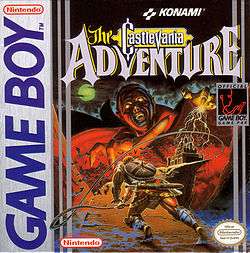Castlevania: The Adventure
| Castlevania: The Adventure | |
|---|---|
 North American box art | |
| Developer(s) | Konami |
| Publisher(s) | Konami |
| Programmer(s) |
Masato Maegawa Yoshiaki Yamada |
| Artist(s) |
Koichi Kimura Nobuya Nakazato |
| Composer(s) |
Shigeru Fukutake Norio Hanzawa Hidehiro Funauchi |
| Series | Castlevania |
| Platform(s) | Game Boy, Game Boy Color, Virtual Console (3DS) |
| Release |
Game Boy
3DS Virtual Console
|
| Genre(s) | Platforming |
| Mode(s) | Single-player |
Castlevania: The Adventure[lower-alpha 1] is a platform game released for the Game Boy in 1989. It is the first Castlevania title for the system. Castlevania: The Adventure was re-released in color as part of the Konami GB Collection compilations in Japan and Europe. A remake titled Castlevania: The Adventure ReBirth was released as a WiiWare game for the Wii.
Gameplay

Set a century before the events of the original Castlevania, the player controls an ancestor of Simon Belmont named Christopher Belmont who goes on a quest to defeat Dracula.[1][3][4]
The game consists of four stages, and unlike other Castlevania games, there are no sub-weapons, but hearts are used to restore health.[1] The player has three lives, after which the player must restart the level.[4] Weapons can be upgraded, such as the whip into the chain whip and flame whip, but any enemy damage will downgrade an upgraded weapon.[4] There are no stairs, unlike other Castlevania games.[4] At the end of each level, there is a "primary evil" to confront.[5] Players can utilize crystals, hearts, and crosses of gold.[5] There is also a point counter, and at 10,000 points, a player receives an extra life, and also receives one for every 20,000 points after that.[5] Each stage also has a time limit in which to complete the level.[5]
Reception and legacy
Castlevania: The Adventure received mixed reviews. The game was regarded difficult at times, with long levels and only three lives before playing the second cycle. The graphics were thought to be "competent", the music well-composed with memorable tunes.[4] IGN said it had a basic design, none of the series' staple bosses, and nothing original.[1] Game Informer's Tim Turi felt that it was held back by its technical limitations but praised its sound quality.[6]
Comic book
A series of comic books were released in 2005 by IDW Publishing called Castlevania: The Belmont Legacy, which centered on the character of Christopher Belmont.[7]
Notes
References
- 1 2 3 4 Mark Bozon (2007-01-18). "Castlevania: The Retrospective". IGN. p. 5. Retrieved 2008-07-12.
- ↑ Perfect Selection Dracula ~New Classic~ (Media notes). King Records Co., Ltd. 1992.
- ↑ Konami staff, ed. (1991). Castlevania II: Belmont's Revenge instruction manual. Konami. p. 11. ???-CW-USA.
- 1 2 3 4 5 "Castlevania: The Adventure (1989)". GameSpy. 1999-01-01. Retrieved 2010-01-31.
- 1 2 3 4 Konami staff, ed. (1989). Castlevania: The Adventure instruction manual. Konami. DMG-CV-USA.
- ↑ Turi, Tim (2012-04-04). "Ranking The Castlevania Bloodline". Game Informer. Retrieved 2013-12-05.
- ↑ "Castlevania: The Belmont Legacy". GameSpy. 2005-01-01. Retrieved 2010-01-31.